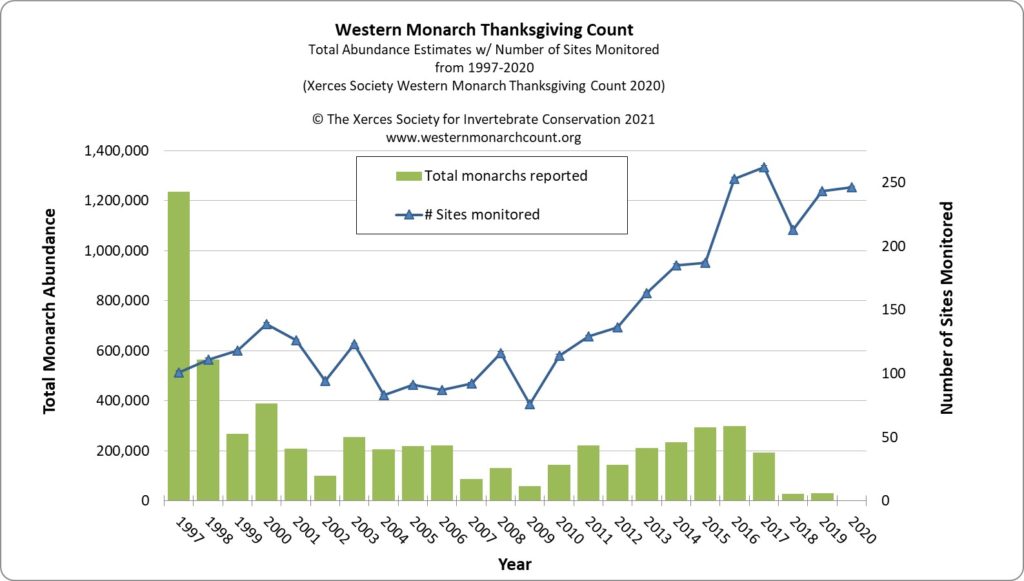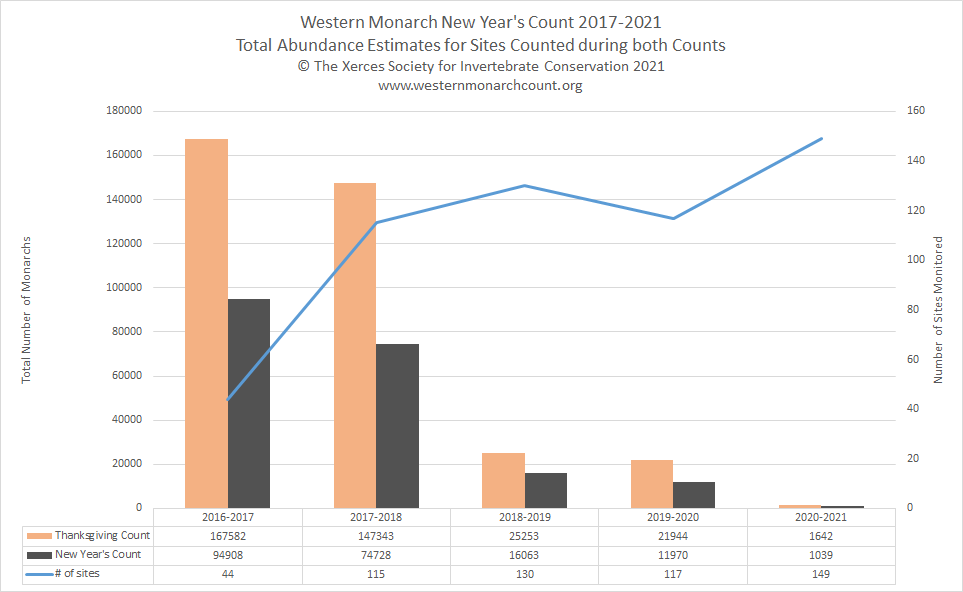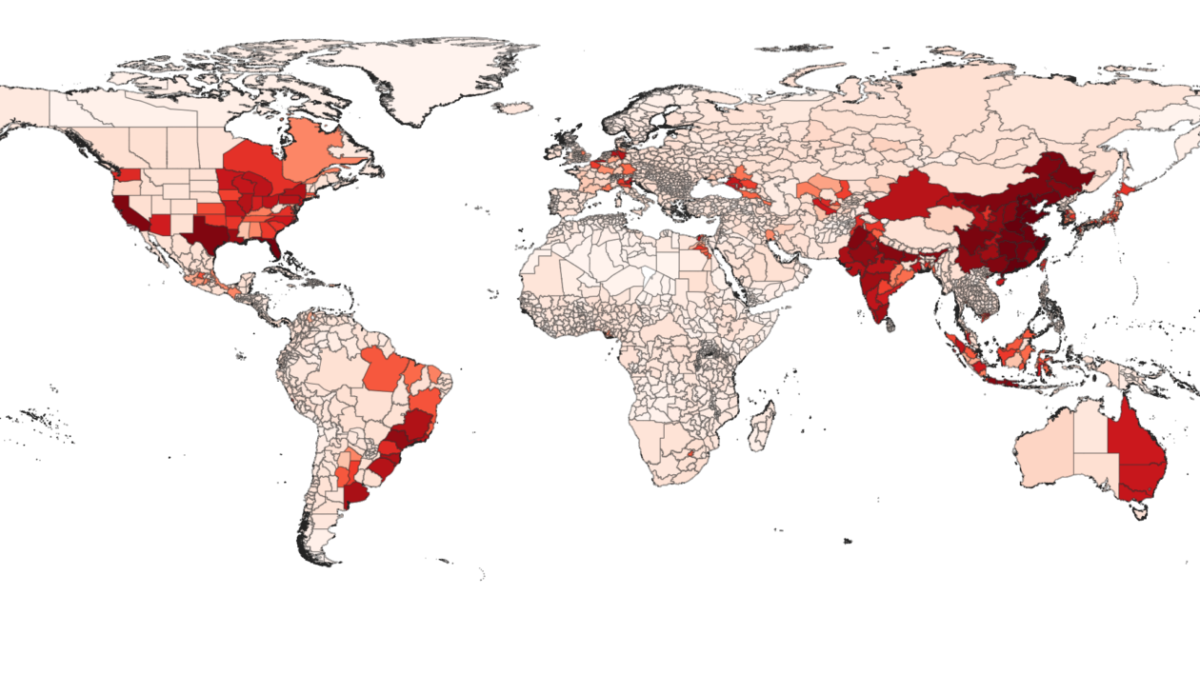Western Monarch butterfly population closer to extinction – No Endangered Species Act protection in sight – “In only a few decades, a migration of millions has been reduced to less than two thousand butterflies”

PORTLAND, Oregon, 19 January 2021 – The Xerces Society today announced that only 1,914 monarch butterflies were recorded overwintering on the California coast this year. This critically low number follows two years with fewer than 30,000 butterflies—the previous record lows—indicating that the western monarch butterfly migration is nearing collapse.
The final results from the 24th annual Western Monarch Thanksgiving Count show a 99.9% fall from the number of monarchs in the 1980s, when butterflies filled trees from Marin County to San Diego County.
“In only a few decades, a migration of millions has been reduced to less than two thousand butterflies,” said Stephanie McKnight, a conservation biologist with the Xerces Society who helps coordinate the counting.
The Western Monarch Thanksgiving Count is a volunteer-driven community science monitoring project that annually assesses the number of monarch butterflies overwintering at groves of trees on the Pacific Coast of California and Northern Baja. The count is coordinated by the Xerces Society for Invertebrate Conservation and Mia Monroe, count founder and longtime volunteer coordinator. This is the primary way that the status of the western monarch migratory population is assessed.
Despite the COVID-19 pandemic hampering survey efforts, volunteers visited 246 overwintering sites—three more than last year—ranging from Mendocino on California’s northern coast to Ensenada in Baja California, Mexico.
“Volunteers rallied to make safe, independent site visits this season realizing the data we each collect is especially important in this dismal year documenting the monarch butterfly’s decline,” said Mia Monroe.
The iconic monarch overwintering sites at Pacific Grove, known as “Butterfly Town, USA”, was one of several that didn’t have a single butterfly this year. Other well-known locations such as the Pismo State Beach Monarch Butterfly Grove and Natural Bridges State Park only hosted a few hundred butterflies.

“These sites normally host thousands of butterflies and their absence this year was heartbreaking for volunteers and visitors flocking to these locales hoping to catch a glimpse of the awe inspiring clusters of monarch butterflies,” noted Sarina Jepsen, Director of Endangered Species at the Xerces Society.
The primary drivers of decline are loss of overwintering, breeding, and migratory habitat in California, and pesticide use.
Unfortunately monarchs lack state and federal legal protection to keep their habitat from being destroyed or degraded. A court decision in November, 2020, deemed that terrestrial invertebrates (including insect pollinators such as the monarch and bumble bees) cannot be offered protection under the California Endangered Species Act. A few weeks later, the US Fish and Wildlife Service announced that monarch butterflies are “warranted but precluded” from listing under the federal Endangered Species Act, making them a Candidate Species for federal protection.
Western monarchs may lack the legal protection that would usher in resources to help recover the population, but there are many things that can be done to improve their chances. The Xerces Society along with other researchers and partners developed the Western Monarch Call to Action. It provides five key steps that if implemented quickly, can help recover the population. This rapid approach aims to complement long-term plans such as the Western Association of Fish & Wildlife Agencies (WAFWA) plan. There are many habitat restoration projects in progress right now to enhance and restore monarch breeding and overwintering habitat in California, but more are needed. Most urgently, overwintering habitat in California needs protection.
The Xerces Society will continue to pursue protection for the monarch and work with a wide variety of partners to implement science-based conservation actions urgently needed to help the iconic and beloved western monarch butterfly migration. Xerces will work hand-in-hand with farmers and ranchers to find practical solutions to restore and manage pollinator habitat on working landscapes and work with managers of roadsides, energy infrastructure, forests, and grasslands to enhance current habitat and create new habitat. Xerces will also continue collaborating with community scientists and enthusiasts, other nonprofits, and researchers to magnify each individual’s efforts.
- Western Monarch Thanksgiving Count Data: https://www.westernmonarchcount.org/data/
- Western Monarch Call to Action: https://xerces.org/western-monarch-call-to-action
Contact
- Sarina Jepsen, Director of Endangered Species, (971) 244-3727, sarina.jepsen@xerces.org
- Scott Hoffman Black, Executive Director, scott.black@xerces.org, 503-449-3792
Western Monarch Population Closer to Extinction; Still no Federal or State Protection in Sight


